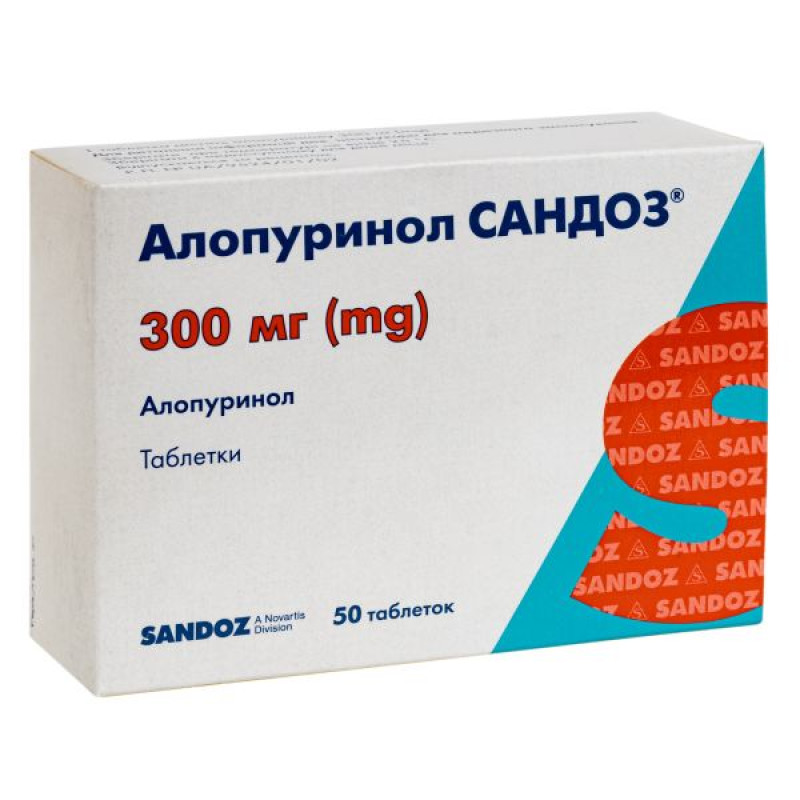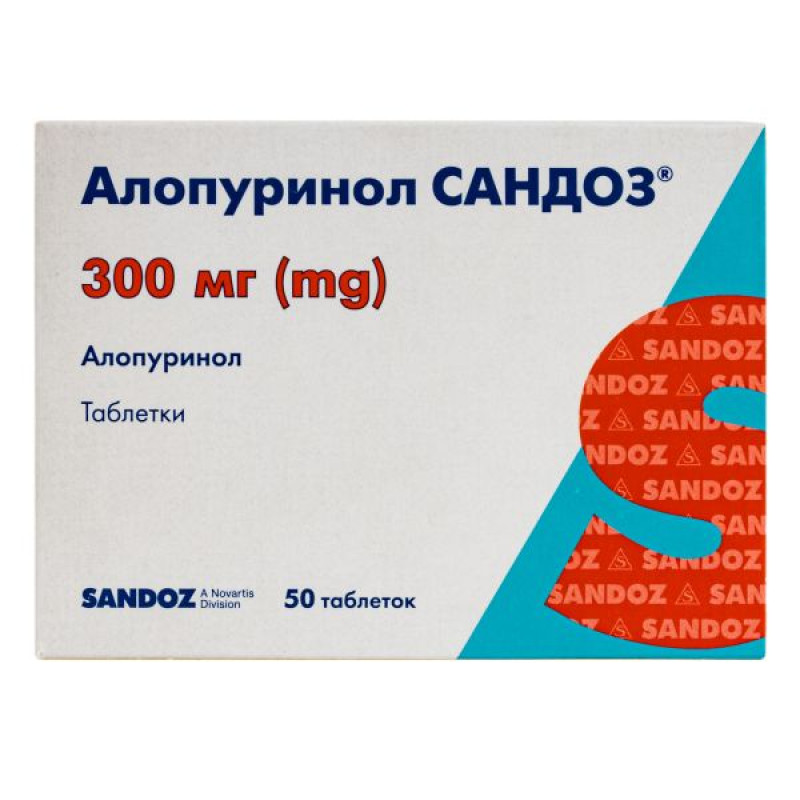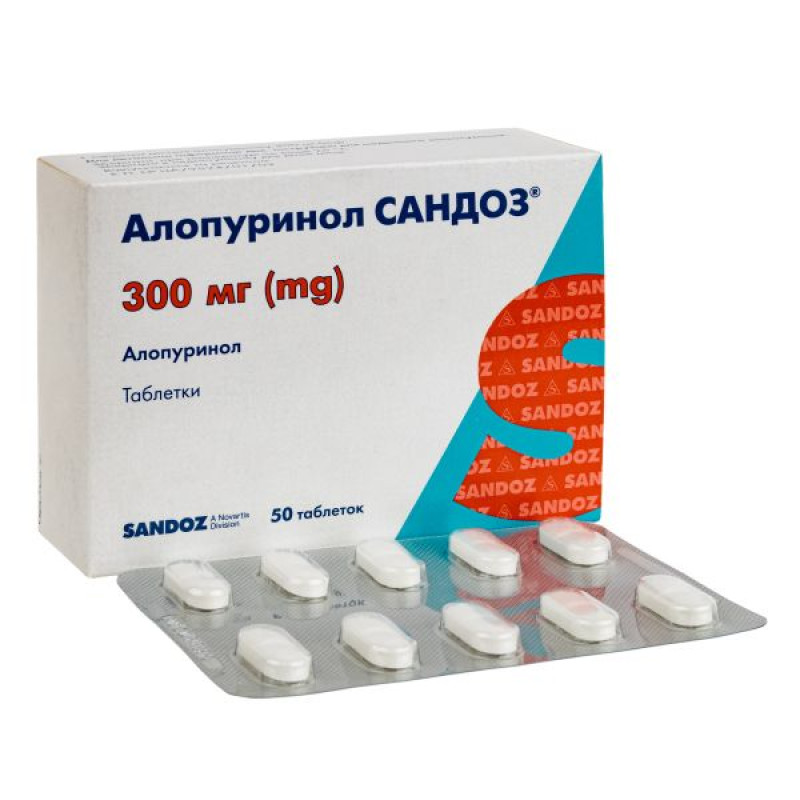Allopurinol Sandoz tablets 300 mg No. 50

Instructions for use Allopurinol Sandoz tablets 300 mg No. 50
Composition
active ingredient: allopurinol;
1 tablet contains allopurinol 100 mg or 300 mg;
excipients: powdered cellulose, povidone, macrogol 4000, crospovidone, talc, magnesium stearate, microcrystalline cellulose.
Dosage form
Pills.
Main physicochemical properties:
300 mg tablets – white or almost white oblong, biconvex tablets with a score on both sides and an intact surface.
Pharmacotherapeutic group
Drugs that inhibit the formation of uric acid. ATC code M04A A01.
Pharmacological properties
Pharmacodynamics
Allopurinol and its main metabolite oxypurinol disrupt the synthesis of uric acid and have urostatic properties, which are based mainly on the ability to inhibit the enzyme xanthine oxidase, which catalyzes the oxidation of hypoxanthine to xanthine and xanthine to uric acid, which leads to a decrease in the concentration of uric acid and promotes the dissolution of urates.
Pharmacokinetics
Allopurinol is rapidly absorbed from the upper gastrointestinal tract. After oral administration, allopurinol is detected in the blood plasma within 30–60 minutes. The bioavailability of the drug is 67–90%.
Peak plasma concentrations of allopurinol and its metabolite oxypurinol are reached 1.5 hours and 3–5 hours after administration, respectively. Allopurinol is almost not bound to plasma proteins. Its volume of distribution is approximately 1.3 l/kg.
Allopurinol is rapidly (plasma half-life 1–2 hours) oxidized by xanthine oxidase and aldehyde oxidase to oxypurinol, which is also a potent inhibitor of xanthine oxidase, but the half-life of the metabolite can be as long as 13 to 30 hours. Given the long half-life of oxypurinol, gradual accumulation may occur at the beginning of therapy until steady-state plasma concentrations are reached. In patients with normal renal function, the mean plasma concentration of oxypurinol is usually 5–10 mg/L after a single dose of 300 mg allopurinol.
Allopurinol is excreted primarily by the kidneys, with less than 10% of the drug excreted unchanged. Approximately 20% of allopurinol is excreted in the feces. Oxypurinol is excreted unchanged in the urine after tubular reabsorption.
Impaired renal function leads to a prolongation of the half-life of oxypurinol, therefore, patients with renal insufficiency should follow the dosage recommendations.
Indication
Treatment of diseases caused by increased uric acid levels in the blood and the formation of urate/oxalate stones (e.g. gout, acute urate nephropathy and urate urolithiasis), as well as for the treatment of malignant neoplasms that potentially lead to exacerbation of all forms of hyperuricemia, namely in various hemoblastoses (acute leukemia, chronic myelogenous leukemia, lymphosarcoma), urate nephropathy resulting from the treatment of leukemia. Congenital enzymatic deficiency, in particular Lesch-Nyhan syndrome (partial or complete deficiency of hypoxanthine-guanine-phosphoribosyltransferase) or adenine-phosphoribosyltransferase deficiency. Treatment of diseases caused by insufficient activity of adenine-phosphoribosyltransferase and the formation of 2,8-dihydroxyadenine stones in the kidneys. Treatment of diseases caused by the formation of mixed calcium-oxalate kidney stones in hyperuricosuria that are not controlled by diet.
Contraindication
Hypersensitivity to allopurinol or to any of the components of the drug.
Interaction with other medicinal products and other types of interactions
6-mercaptopurine and azathioprine. When allopurinol is taken simultaneously with 6-mercaptopurine or azathioprine, the doses of the latter should be reduced by 25%, since the metabolism of these drugs is slowed down due to inhibition of xanthine oxidase, and their effect is prolonged.
Vidarabine (adenine arabinoside). The simultaneous use of allopurinol with vidarabine prolongs the half-life of the latter from blood plasma, so this combination should be used with caution to avoid possible increased toxic effects.
Salicylates and drugs that promote the excretion of uric acid. The effectiveness of allopurinol may be reduced when used concomitantly with drugs that can excrete uric acid (sulfinpyrazone, probenecid, benzbromarone or salicylates).
Oxypurinol, the main metabolite of allopurinol, with independent therapeutic activity, is excreted by the kidneys in a similar way to the excretion of uric acid salts. Accordingly, drugs that promote the excretion of uric acid, such as probenecid or salicylates, in high doses, may accelerate the excretion of oxypurinol. As a result, a decrease in the therapeutic activity of allopurinol is possible, but the significance of this factor needs to be assessed in each individual case.
Allopurinol slows down the elimination of probenecid.
Anticoagulants (coumarin derivatives). The effect of warfarin and other anticoagulants - coumarin derivatives may be enhanced, therefore more frequent monitoring of blood coagulation is required, as well as a reduction in the dose of anticoagulants.
Phenytoin: Allopurinol may inhibit the hepatic metabolism of phenytoin, but the clinical significance of this interaction has not been proven.
Theophylline, caffeine. In high doses, allopurinol inhibits the metabolism and increases the plasma concentration of theophylline, caffeine. At the beginning of treatment with allopurinol or when increasing its dose, it is necessary to monitor theophylline levels in the blood plasma.
Ampicillin/amoxicillin: There is a risk of allergic skin reactions (exanthema) when allopurinol is used concomitantly with ampicillin or amoxicillin, therefore patients taking allopurinol should be given other antibiotics.
Cytostatics. When allopurinol is used with cytostatics (cyclophosphamide, doxorubicin, bleomycin, procarbazine, mechlorethamine), increased bone marrow suppression has been observed, therefore blood counts should be monitored at short intervals in such patients.
Cyclosporine: When used with allopurinol, cyclosporine plasma concentrations may increase and its toxicity may increase.
Didanosine: Concomitant use with allopurinol is not recommended as an almost two-fold increase in Cmax and AUC of didanosine has been observed.
Captopril: Concomitant use of allopurinol and captopril may increase the risk of skin reactions, especially in chronic kidney disease.
Diuretics.
Concomitant use of allopurinol and furosemide may increase plasma concentrations of urate and oxypurinol. An increased risk of hypersensitivity has been reported when allopurinol is used with diuretics, particularly thiazides, especially in the presence of impaired renal function.
Angiotensin-converting enzyme (ACE) inhibitors.
An increased risk of hypersensitivity has been reported when allopurinol is used with ACE inhibitors, especially in the presence of impaired renal function.
Aluminum hydroxide.
When used simultaneously with aluminum hydroxide, the effect of allopurinol may be weakened. An interval of at least 3 hours should be observed between taking both drugs.
Application features
If hypersensitivity reactions (DRESS syndrome) occur, including Stevens-Johnson syndrome, toxic epidermal necrolysis, maculopapular exanthema, allopurinol should be discontinued immediately and not re-administered. Corticosteroids may be helpful in controlling cutaneous hypersensitivity reactions.
The presence of the HLA-B*5801 allele (a genetic marker) in patients treated with allopurinol is associated with an increased risk of hypersensitivity reactions. The frequency of this genetic marker varies considerably between ethnic groups (20% of the main Chinese Han ethnic group, 8–15% of Thais, 12% of Koreans, 1–2% of Japanese and Caucasians). If a patient is known to have the HLA-B*5801 allele, allopurinol should only be considered if the expected benefits of treatment outweigh the potential risks.
Such patients should be informed of the need to discontinue treatment at the first symptoms of hypersensitivity syndrome.
Allopurinol is not recommended if the plasma uric acid level is below 535 μmol/L (9 mg/100 mL), following dietary recommendations and in the absence of renal impairment. Avoid foods high in purine (e.g. offal: kidneys, brain, liver, heart and tongue; meat broths and alcohol, especially beer).
If hypersensitivity reactions (e.g. eczema) occur, allopurinol should be discontinued immediately.
In case of impaired renal or hepatic function or previously established disorders of hematopoiesis, particularly careful medical supervision is required. For patients with impaired renal or hepatic function, the appropriate dosage recommendations should be taken into account. Allopurinol should be used with particular caution in patients suffering from arterial hypertension or heart failure and receiving ACE inhibitors or diuretics.
When treating gout and urolithiasis, the volume of urine excreted should be at least 2 liters per day.
To prevent an increase in serum or urine uric acid concentration, which may occur during radiotherapy or chemotherapy of neoplasms, as well as in Lesch-Nyhan syndrome, in addition to allopurinol, large amounts of fluid should be taken to maintain sufficient diuresis. In addition, to improve the excretion of uric acid, alkalinization of the urine, which leads to the dissolution of urates/uric acid, can be performed.
If urate nephropathy or other pathological changes have already caused renal dysfunction, the dose should be adjusted according to renal function indicators.
In the presence of large uric acid stones in the renal pelvis, it cannot be ruled out that during treatment with allopurinol, some of the stones may dissolve and enter the bladder, which may subsequently cause obstruction of the ureter.
During long-term therapy with allopurinol, thyroid dysfunction, namely increased thyroid-stimulating hormone (TSH) (>5.5 µIU/ml), was observed in 5.8% of patients. Caution is required when using allopurinol in patients with thyroid dysfunction.
Ability to influence reaction speed when driving vehicles or other mechanisms
Until the individual response to allopurinol is determined, caution should be exercised when driving or operating machinery due to the possibility of dizziness, drowsiness, and ataxia.
Use during pregnancy or breastfeeding
There are insufficient data on the use of allopurinol during pregnancy. Since allopurinol affects purine metabolism and the potential risk to humans is unknown, allopurinol is not recommended for use during pregnancy.
Allopurinol passes into breast milk, so the drug should not be taken during breastfeeding.
Method of administration and doses
Adults. The daily dose is determined individually depending on the level of uric acid in the blood serum. To reduce the risk of adverse reactions, treatment should be started with 100 mg of allopurinol once a day and the dosage should be increased only if the level of uric acid in the blood serum is not sufficiently reduced.
The following dosage regimens are recommended:
for mild conditions – from 100 mg to 200 mg per day;
for moderately severe conditions – from 300 mg to 600 mg per day;
in severe conditions: from 700 mg to 900 mg per day.
When calculating the dose of the drug based on the patient's body weight, use doses of 2–10 mg/kg of body weight per day.
Children. For children over 15 years of age, the daily dose of allopurinol is 10–20 mg/kg body weight. The maximum daily dose is 400 mg. Allopurinol is rarely prescribed to children, except for malignant conditions (especially leukemia) and certain enzyme disorders, such as Lesch-Nyhan syndrome.
Elderly patients: Due to the lack of specific data on the use of allopurinol in this category of patients, it is recommended to use the lowest therapeutically justified doses. The possibility of impaired renal function in elderly patients should be taken into account.
Patients with renal insufficiency. Since allopurinol and its metabolites are excreted by the kidneys, overdose is possible in cases of impaired renal function if the dose has not been adjusted appropriately.
In severe renal impairment, the maximum daily dose is 100 mg. A single dose of 100 mg may be administered at intervals of more than 24 hours (every 2–3 days).
If it is necessary to increase the dose, the serum level of oxypurinol should be monitored, which should not exceed 15.2 μg/ml.
During hemodialysis, use 300–400 mg of allopurinol after each session (2–3 times a week).
Serum urate concentrations and urinary uric acid levels should be monitored at specified intervals to adjust the dose of allopurinol.
Patients with impaired liver function.
Patients with impaired liver function should be prescribed lower doses. Periodic monitoring of liver function tests is recommended at the beginning of treatment.
300 mg tablets should not be prescribed to these patients due to the high content of the active substance.
The tablets should be taken after meals, without chewing, with plenty of liquid.
The duration of treatment depends on the course of the underlying disease. In order to prevent the formation of oxalate and urate stones and in primary hyperuricemia and gout, long-term therapy is required in most cases. In secondary hyperuricemia, short-term treatment is recommended according to the duration of the increase in uric acid levels.
Children
Apply to children over 15 years of age.
Allopurinol is rarely prescribed to children, except for malignant conditions (especially leukemia) and certain enzyme disorders, such as Lesch–Nyhan syndrome.
Overdose
Symptoms. After taking a single dose of 20 g, one patient experienced symptoms such as nausea, vomiting, diarrhea, and dizziness. In another patient, a dose of 22.5 g of allopurinol did not cause any undesirable effects. After prolonged intake of 200–400 mg of allopurinol per day in patients with impaired renal function, severe symptoms of intoxication (skin reactions, fever, hepatitis, eosinophilia, and exacerbation of renal failure) have been described. In case of overdose, allopurinol significantly inhibits the activity of xanthine oxidase, but only in the case of simultaneous use with 6-mercaptopurine and azathioprine is the effect of the drug accompanied by significant side effects.
If an overdose is suspected, especially when 6-mercaptopurine and azathioprine are taken simultaneously, you can wash the stomach, induce vomiting, or take activated charcoal and sodium phosphate, if no more than 1 hour has passed after taking the drug.
Treatment. Symptomatic therapy. If necessary, hemodialysis. Specific antidote is unknown.
Adverse reactions
The assessment of undesirable effects is based on information about their frequency: very common (≥ 1/10), common (≥ 1/100, < 1/10), uncommon (≥ 1/1000, < 1/100), rare (≥ 1/10000, < 1/1000), very rare (< 1/10000), frequency unknown (cannot be estimated from the available data).
Reactive gout attacks may occur at the beginning of treatment with allopurinol.
Manifestations of adverse reactions are most frequent in the presence of renal and/or hepatic insufficiency or with simultaneous use with ampicillin or amoxicillin.
On the part of the blood system: rarely - severe bone marrow damage (thrombocytopenia1, agranulocytosis1, aplastic anemia1), especially in patients with renal failure; very rarely - changes in blood parameters (leukopenia, leukocytosis, granulocytosis and eosinophilia), pure red cell aplasia.
Immune system disorders: rare – delayed-type hypersensitivity reactions2, accompanied by fever, skin rashes, vasculitis, lymphadenopathy, pseudolymphoma, arthralgia, leukopenia, eosinophilia, hepatosplenomegaly, abnormal liver function tests (reversible elevation of transaminases and alkaline phosphatase); acute cholangitis and xanthine stones; very rare – anaphylactic reactions, including anaphylactic shock, angioimmunoblastic T-cell lymphoma3.
Gastrointestinal: Rare: nausea4, vomiting4, diarrhea; Very rare: hematemesis, steatorrhea, stomatitis, bowel disorder.
Hepatic: Rarely, hepatic dysfunction5 ranging from asymptomatic elevation of liver function tests to hepatitis (including hepatic necrosis and granulomatous hepatitis)5.
Skin: very rare - rashes, including Stevens-Johnson syndrome (SJS)/toxic epidermal necrolysis (TEN)6; alopecia, furunculosis, angioedema7, hair discoloration, dermatitis.
From the respiratory system, chest organs and mediastinum: very rarely - angina pectoris.
From the nervous system: very rarely common - ataxia, peripheral neuritis, taste disturbance, coma, headache, neuropathy, paralysis, dizziness, drowsiness, paresthesia.
From the cardiovascular system: very rarely - bradycardia, arterial hypertension.
Metabolic disorders: very rarely common – diabetes mellitus, hyperlipidemia.
On the part of the psyche: very rarely, common - depression.
From the reproductive system: very rarely - gynecomastia, impotence, infertility.
From the urinary system: very rarely - hematuria, uremia, azotemia.
On the part of the organs of vision: very rarely - cataracts, retinal degeneration, visual impairment.
Musculoskeletal system: very rarely, common - muscle pain.
General disorders: very rarely common – malaise, asthenia, edema, pyrexia8.
On the part of the auditory organs: dizziness.
Research: increased TSH levels in the blood.
1 Thrombocytopenia, agranulocytosis and aplastic anemia have been reported very rarely, especially in individuals with renal and/or hepatic impairment, which requires closer attention to such patients.
2 Delayed-type hypersensitivity reactions (DRESS syndrome) with fever, rash, vasculitis, lymphadenopathy, pseudolymphoma, arthralgia, leukopenia, eosinophilic hepatomegaly, liver dysfunction including destruction and disappearance of intrahepatic bile ducts may occur in various combinations. Other organs (e.g. liver, lung, kidney, pancreas, myocardium and colon) may also be affected. If such reactions occur, allopurinol should be discontinued immediately and not re-administered. Allopurinol should not be re-administered if hypersensitivity reactions, including SJS/TEN, occur. Corticosteroids may be used to manage cutaneous hypersensitivity reactions. Renal and/or hepatic dysfunction is usually present when generalised hypersensitivity reactions occur, particularly in fatal cases.
3 Angioimmunoblastic T-cell lymphoma has been reported very rarely following biopsy of generalized lymphadenopathy. This condition was reversible upon discontinuation of allopurinol.
4 Nausea and vomiting have been reported in early clinical trials with allopurinol. This problem can be avoided by taking allopurinol after meals.
6 Cutaneous reactions are the most common and may occur at any time during treatment. These reactions may present as purpuric, maculopapular, squamous or exfoliative rashes (SRS/TEN). The greatest risk of SRS/TEN or other serious hypersensitivity reactions occurs during the first weeks of treatment. Early diagnosis and immediate discontinuation of any suspected drug can avoid more serious consequences. If such reactions occur, allopurinol should be discontinued immediately. When allopurinol is restarted, it is advisable to start treatment at a low dose (e.g. 50 mg/day) and increase it gradually. The HLA-B*5801 allele has been shown to be associated with the risk of hypersensitivity reactions and SRS/TEN with allopurinol. However, the use of genotyping as a screening tool for deciding on allopurinol treatment has not been established. If rash recurs during treatment with allopurinol, the drug should be discontinued immediately, as more serious hypersensitivity may develop. If the development of SJS/TEN or other serious hypersensitivity reactions cannot be ruled out, allopurinol should not be re-administered, as this may lead to serious or even fatal reactions. The clinical diagnosis of SJS/TEN remains the basis for decision-making. If such reactions occur during treatment, allopurinol should be discontinued immediately.
7 Angioedema with/without signs and symptoms of a generalised hypersensitivity reaction has been reported.
8 Fever with/without signs and symptoms of a generalized hypersensitivity reaction has been reported.
9 The detection of elevated TSH levels in relevant studies does not indicate any effect on free T4 levels, or this TSH level indicates subclinical hypothyroidism.
Expiration date
5 years.
Storage conditions
Store at a temperature not exceeding 25 °C.
Keep out of reach of children.
Packaging
10 tablets in a blister; 5 (10 ´ 5) blisters in a cardboard box.
Vacation category
According to the recipe.
Producer
Salutas Pharma GmbH, Germany (full-cycle production).
Location of the manufacturer and its business address
Otto-von-Güricke-Allee 1, 39179 Barleben, Germany.
There are no reviews for this product.
There are no reviews for this product, be the first to leave your review.
No questions about this product, be the first and ask your question.





